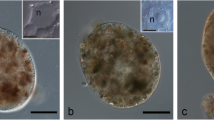Summary
The localization of two carbohydrate binding proteins, so-called lectins, was studied in the sponge tissue of Axinella polypoides by light and immunofluorescence microscopy. They do not occur at the cellular surface of any cell type, but they are stored in vesicles of the “spherulous cells”. After short formaldehyde fixation spherulous cells can be isolated and they release the active lectins upon lysis in distilled water.
Electron microscopical studies of spherulous cells show that they contain almost nothing else but a small nucleus and vesicles of different size and number. Small vesicles are full of an electron dense material, whereas the content of large vesicles has a fluffy and fibrillar structure. Spherulous cells are large and tightly packed in the outer layer of the ectosome and in the mesh work of the spongin fibres of the central axis. They are small and scattered in the inner layer of the ectosome, and they are found throughout the choanosome. The function of the lectins is not clearly defined, and different alternatives such as participation in glycoprotein synthesis, immunological defense, or carbohydrate transport are possible.
Similar content being viewed by others
References
Baldo, B.A., Uhlenbruck, G., Steinhausen, G.: Antigalactan agglutinins from the marine sponge Axinella polypoides (Schmidt). Biol. Zbl. 96, 723–733 (1977)
Bretting, H.: Serologische und immunelektrophoretische Untersuchungen über zwei Agglutinine, aufgefunden in den Schwämmen Aaptos papillata (Keller) und Axinella polypoides (Schmidt). Z. Immuno.-Forsch. 146, 239–259 (1973)
Bretting, H., Gerstacker, H.: Die Bestimmung der Bindungskonstanten K0 und der Zahl der Bindungsstellen für das mitogene Lektin I und dessen strukturelle Beziehungen zu dem amitogenen Lektin II aus dem Schwamm Axinella polypoides (Schmidt). Z. Immun.-Forsch. 155, 144–154 (1978)
Bretting, H., Kabat, E.A.: Purification and characterization of the agglutinins from the sponge Axinella polypoides and a study of their combining sites. Biochemistry 15, 3328–3236 (1976)
Bretting, H., Kabat, E.A., Liao, J., Pereira, M.E.A.: Purification and characterization of the agglutinins from the sponge Aaptos papillata and a study of their combining sites. Biochemistry 15, 5029–5038 (1976)
Bretting, H., Kalthoff, H., Fehr, S.: Studies on the relationship between lectins from Axinella polypoides agglutinating bacteria and human erythrocytes. J. Invertebr. Pathol. 32, 151–157 (1978)
Brien, P.: Malawispongia echinoides. Rev. Zool. Bot. Afro. 86, 65–92 (1972)
Dodd, R.Y., MacLennan, A.P., Hawkins, D.C.: Hemagglutinins from marine sponges. Vox Sang. 15, 386–391 (1968)
Donadey, C., Vacelet, I.: Les cellules à inclusions de l'éponge Pleraplysilla spinifera (Schulze). Arch. Zool. exp. et gen. 118, 273–284 (1977)
Gold, E.R., Phelps, C.F., Khalap, S., Balding, P.: Observations on Axinella sp. hemagglutinin. In: Biochemical Perspectives of Agglutinins of Invertebrate and Plant Origin (E. Cohen, ed.). Ann. N.Y. Acad. Sci. 122–127 (1974)
Goldstein, I.J., Hayes, C.E.: The Lectins: carbohydrate-binding proteins of plants and animals. Adv. Carbohydr. Chem. Biochem. 35, 125–340 (1978)
Hamblin, J., Kent, S.P.: Possible role of phytochemagglutinin in Phaseolus vulgaris L. Nature New Biol. 245, 28–30 (1973)
Hammarström, S., Hellström, U., Perlmann, P., Dillner, M.-L.: A new surface marker on T lymphocytes of human peripheral blood. J. Exp. Med. 138, 1270–1275 (1973)
Holstein, A.F., Wulfhekel, U.: Die Semidünnschnitt-Technik als Grundlage für eine cytologische Beurteilung der Spermatogenese des Menschen. Andrologie 3(2), 65–69 (1971)
Inbar, M., Sachs, L.: Mobility of carbohydrate containing sites on the surface membrane in relation to the control of cell growth. FEBS Lett. 32, 124–128 (1973)
Jenkin, C.R., Hardy, D.: Recognition factors of the Crayfish and the generation of diversity. Aust. J. exp. Biol. Med. Sci. 64, 55–65 (1975)
Junqua, S., Fayolle, J., Robert, L.: Structural glycoproteins from sponge intercellular matrix. Comp. Biochem. Physiol. 50B, 305–309 (1975)
Kabat, E.A.: Some perspectives for future immunochemical research with blood group substances. Human Blood Groups 5th Int. Convoc. Immunol. Buffalo N.Y., 236–245 (1976)
Khalap, S., Thompson, T.E., Gold, F.R.: Haemagglutination and haemagglutination inhibition reactions of extracts from snails and sponges. I. Agglutination of human and various animal red blood cells: Its inhibition by sugars and aminosugars. Vox Sang. 18, 501–526 (1970)
Khalap, S., Thompson, T.E., Gold, F.R.: Haemagglutination and haemagglutination inhibition reactions of extracts from snails and sponges. II. Haemagglutination-inhibition tests with biological material and some substances contained in them. Vox Sang 20, 150–173 (1971)
Ling, N.R., Kay, J.E.: Lymphocyte stimulation. 2nd ed. Amsterdam: North Holland Publishing Co. 1975
Lis, H., Sharon, N.: Lectins: Their chemistry and application to immunology. In: The Antigens (M. Sela, ed.) Vol. IV, pp. 459–529 New York: Academic Press 1977
Renwrantz, L., Mohr, W.: Opsonizing effect of serum and albumin gland extracts on the elimination of human erythrocytes from the circulation of Helix pomatia. J. Invertebr. Pathol. 31, 164–170 (1978)
Reynolds, E.S.: The use of lead citrate at high pH as an electron-opaque stain in electron microscopy. J. Cell Biol. 17, 208–213 (1963)
Uhlenbruck, G., Steinhausen, G.: Tridacnins: Symbiosis-profit or defense-purpose? Develop. Comp. Immunol. 1, 183–192 (1977)
Vacelet, J.: Etude en microscopic électronique de l'association entre bactéries et spongiaires de genre Verongia (Dictyoceratida). J. Microscopie et de Biol. cell. 23, 271–288 (1975)
Author information
Authors and Affiliations
Additional information
This study was supported by a grant from the Deutsche Forschungsgemeinschaft
We are gratefully indebted to Dr. D. Keyser for his help in our electron microscopical studies
Rights and permissions
About this article
Cite this article
Bretting, H., Königsmann, K. Investigations on the lectin-producing cells in the sponge Axinella polypoides (Schmidt). Cell Tissue Res. 201, 487–497 (1979). https://doi.org/10.1007/BF00237007
Accepted:
Issue Date:
DOI: https://doi.org/10.1007/BF00237007




